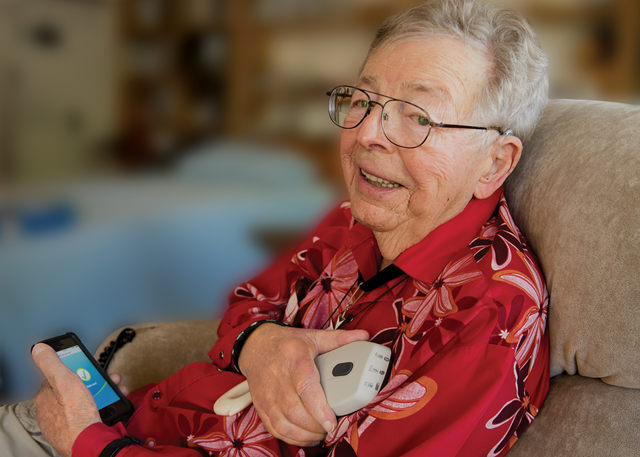Canadians are among the most digitally connected in the world. Combined with our geographic spread, this digital presence makes Canadians ideal users of remote patient monitoring, which is already being used by thousands of Canadians. The latest trend in remote care is mobile app technology, with over 100,000 healthcare apps already at the disposal of patients, caregivers, and clinicians. One of the latest apps is the world’s first app-based remote monitoring system for pacemakers, launched in Canada in February 2016. For the first time in Canada, patients with select pacemakers can use their #smartphones to transmit their #pacemaker data to their clinic, rather than relying on dedicated technology provided by the pacemaker company.
Remote patient monitoring provides significant benefits to patients who are able to reduce the number of trips they have to make to a clinic, while still being able to perform a check-up. In June 2014, a study commissioned by Canada Health Infoway cited several other benefits of remote patient monitoring, including fewer hospital readmissions and emergency room visits, better health outcomes, and improved quality of life for patients. It also noted that remote patient monitoring had been growing at a rate of 15 to 20 per cent annually.
In 2015, comScore estimated that over 62 per cent of Canadian phone owners 55 years and older owned a smartphone and over 1.5 million Canadians used mobile devices exclusively to access the internet. The ease and simplicity of using an app on a mobile device provides a platform that can be used by patients of any age, from children to seniors.
The same platform is also versatile enough to allow monitoring and reporting from virtually anywhere in the world, and/or enable transmission to a family member or care provider to ensure patients are keeping to their reporting timelines. One such example is Earl Bakken, 92, who lives in Hawaii and uses his smartphone to send his pacemaker transmissions from the comfort of his home. If the name sounds familiar, it’s because Bakken developed the first external, battery-operated, transistorized, wearable artificial pacemaker in 1957 and is the founder of #Medtronic, one of the largest medical technology companies in the world. He now benefits from the technology he helped create.
Since the introduction of the pacemaker five decades ago, it has the distinction of being among the first medical devices to enable data transmission over analog telephone lines, as a means to reduce the number of visits to a clinic for routine checks.
That being said, early iterations were cumbersome and information gathered was rudimentary (mainly battery status). Just over a decade ago, second generation devices were introduced that took reporting to full device checks, including battery status, historical data and diagnostic information.
Monitoring required a dedicated instrument that needed to be connected to a standard analog telephone line. A wand would have to be passed over the device to take and transmit readings. Given pacemaker patients are generally older, the process was often too cumbersome, leading to double or triple transmissions or omissions. Another limitation was that these systems could only be used within continental North America, restricting travel options.
The shift to smartphones and tablets, combined with near-ubiquitous access to Wi-Fi or cellular services has altered the landscape considerably. Not only is the technology familiar to most patients and/or their family members, monitoring and reporting to clinicians can be conducted from anywhere in the world where there is access to an internet connection. Monitoring can also be set up in such a way that family members and caregivers can be automatically notified if a transmission is scheduled to be done or has taken place.
Patients also have the option of which service providers and platform they wish to use. The MyCareLink Smart™ Monitor for Medtronic implantable pacemakers, for example, allows patients to use their own Apple® or Android™ smartphone or tablet to transmit data to their physician or other caregiver over Wi-Fi or cellular signal, through the service provider of their choosing. Users simply download the free app to their smartphone or tablet, place the reader over the heart device and follow the instructions on the screen.
Having a simple, flexible and portable option for patients plays an integral role in ensuring the sustainability of remote patient monitoring. As the population of patients requiring remote monitoring grows, it is essential that technology keeps pace with solutions that encourage patient acceptance and engagement. We have seen significant strides in the area of app-based solutions on all fronts – a factor that bodes well for remote patient monitoring’s future.


